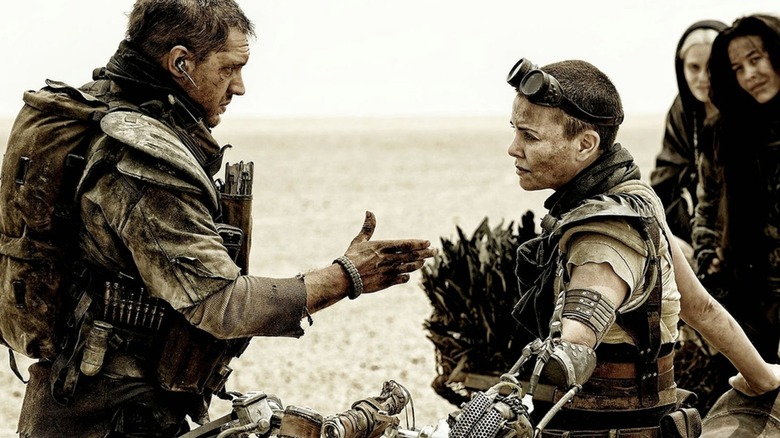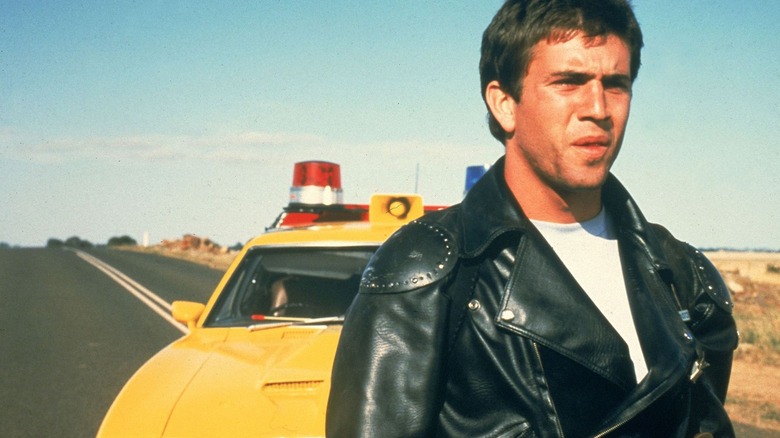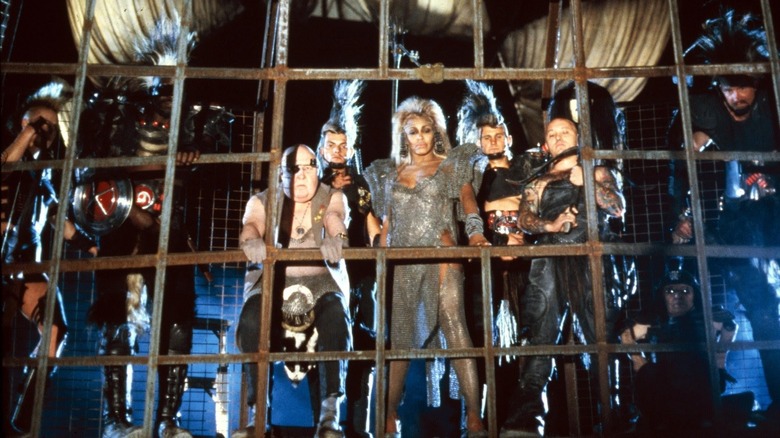The Correct Order To Watch The Mad Max Movies
"Furiosa: A Mad Max Saga" releases in May next year, acting as both a spin-off and prequel to George Miller's "Mad Max: Fury Road." The legacy of "Fury Road" remains unstated to this day, as it emerges as an essential film that critiques totalitarianism and urges a perspective where people are more than vehicles for capitalistic consumption. "Furiosa" is set to etch the journey of the titular former war captain, who needs to survive several trials thrown her way while navigating the unforgiving Wasteland brimming with dangers. However, Miller's "Mad Max" legacy extends beyond these contemporary offerings, spanning back to his 1979 film, "Mad Max," the low-budget gem that birthed a franchise with a profoundly layered core message.
The overwhelming popularity of "Fury Road" — which has been rightfully earned over the years — might have unfortunately overshadowed Miller's "Mad Max" trilogy that set the stage for the bleak and violent world he has committed to fleshing out over time. At the time, the terrifying no man's land in these films was shrouded in mystery, as there were scant explanations about the mechanics of a dystopian society marked with death and devastation. Now, we know better, thanks to Miller's relentless dedication to bringing such an anarchic world to life, rife with power-hungry individuals and a handful of unconventional heroes who need to constantly focus on mere survival.
Here's the correct order to watch the "Mad Max" films, which trace a somewhat linear journey of societal collapse, unhinged marauders, and the rise of a terrifying power structure that sports its unique rules.
The only correct way to watch the Mad Max films
To understand Miller's vision in all its glory, it is best to start with the original "Mad Max," which still feels chilling 44 years since its release. Miller keeps things fairly simple compared to the adrenaline-fueled sequels, focusing on Max Rockatansky (Mel Gibson), who is forced to go sicko-mode by the end of the third act. Max's motive is revenge, as he needs to punish those who took everything from him, and every emotion is primarily conveyed through sight and sound, where dialogue takes a backseat in this visceral portrait of brutality. Put together on a shoestring budget, "Mad Max" is one of those films that attain more layers in hindsight, as it essentially sowed the seeds for a universe bound to stun and arrest our attention.
While "Mad Max" is more of a cultural landmark in post-apocalyptic filmmaking, its sequel, "Mad Max: The Road Warrior," solidifies the "Mad Max' legacy by pitting Max against a band of unruly marauders. Here, the combat sequences are more gritty, and the worldbuilding is more intense, highlighting the ruthless nature of the terrain that the inhabitants are forced to call home. This is a worthy follow-up with a flawed treatment of characters, where much of the nuance is lost due to a hyperfocus on a heroic figure with a one-track mind.
However, once you watch the third installment, "Beyond Thunderdome," it becomes clear that the franchise's strength is its worldbuilding, where structures like the gladiator-style Thunderdome immediately achieve iconic status. While this entry is rather flawed and inconsistent story-wise, the lead-up to "Fury Road" makes this chaotic journey worth it, as it opens avenues to a world with rich, layered characters and an unforgettable sage about violence and identity.
Mad Max and beyond
In "Fury Road," the state of society is more dire than ever: people are reduced to utilitarian tools, women are perceived as breeding stock, and power structures are hinged on twisted rules of strength and influence. Cults are on the rise, countless generations are radicalized and brainwashed, crafting a system where tyranny and exploitation go hand-in-hand. A slight shift in this status quo upends this highly industrial society, and everyone must fight to the death in this charred landscape for varying reasons, ranging from redemption to survival.
While "Fury Road" and the original trilogy are enough to cement our understanding of this mad, mad world, coupled with the release of "Furiosa" around the corner, there still lies a wealth of adjacent lore waiting to be excavated. A 1990 video game titled "Mad Max" — based on the second film in the series — takes the survival horror approach where players need to fight other factions and survive, making resource management pivotal to the experience. While this wasn't super combat-heavy, 2015's "Mad Max" game includes vehicular combat while the tale is set in a vast open world with bleak canyons and endless deserts.
On the literary front, the first three movies have been novelized, apart from a limited comic book series by Miller himself, titled "Mad Max: Fury Road." The story is a prequel to the 2015 film, honing in on characters such as Imperator Furiosa and Immortan Joe, and there's much to glean from these stories, considering that they have been helmed by Miller.
While "Fury Road" is undoubtedly Miller's masterwork within the series, the trilogy is essential to the "Mad Max" world, where they are best explored with the mindset of immersing oneself into a vision that is one of a kind.


